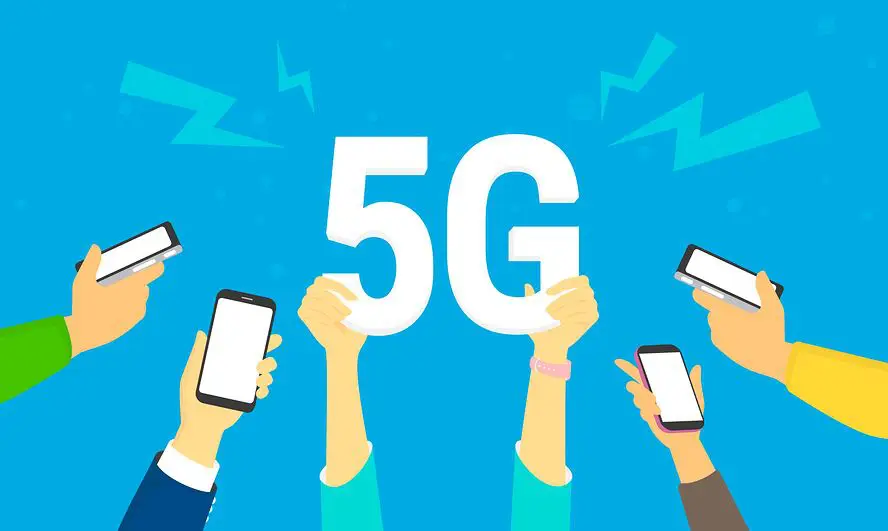Table of Contents
5G technology in India – Advantages and Challenges | UPSC – IAS
Fifth Generation (5G) technology is generally seen as the 5th generation cellular network technology that provides broadband access. The industry association 3GPP defines any system using “5G NR” software as “5G”, a definition that came into general use by late 2018
Fifth Generation (5G) technology is a wireless communication technology using radio waves or radio frequency (RF) energy to transmit and receive data. fifth generation is the next generation mobile networks technology after 4G LTE networks. 5G technologies will enter services gradually, beginning in 2019 and advance to a full range of services by 2024. 5G connections in India are forecasted to reach 88 million by 2025, equivalent to around 7% of the total connections base in the country.
Fifth Generation (5G) technology will underwrite USD 12.3 trillion of worldwide economic output by 2035, with investment within the value chain expected to get an extra USD 3.5 trillion in output and supply support for 22 million jobs by 2035.
Difference between 5G and other Generation | UPSC – IAS
- 2G and 3G mobile networks relied on microwave wireless backhaul to connect cell sites with the nearest switching centre.
- 4G LTE introduced IP-based connectivity, replacing copper- or microwave-based cell sites with optical fibre.
- 5G deployment is based on optical fibre infrastructure.
| Generation | 2G | 3G | 3G HSPA+ | 4G | 4G LTE-A | 5G |
| Max speed | 0.3Mbps | 7.2Mbps | 42Mbps | 150Mbps | 300Mbps-1Gbps | 1-10Gbps |
| Average speed | 0.1Mbps | 1.5Mbps | 5Mbps | 10Mbps | 15Mbps-50Mbps | 50Mbps and up |
Advantages of 5G Technology | UPSC – IAS
- Faster Data Speed – Currently 4G networks are capable of achieving the peak download speed of one gigabit per second. With Fifth Generation (5G) the speed could be increased upto 10Gbps.
- Ultra-low latency – Latency refers to the time it takes for one device to send a packet of data to another device. In 4G the latency rate is around 50 milliseconds but 5G will reduce that to about 1 millisecond.
- A more Connected World – 5G will provide the capacity and bandwidth as per the need of the user to accommodate technologies such as Internet of Things. Thus, will help to incorporate Artificial Intelligence in our lives. It can also support Virtual Reality and Augmented Reality services.
As per the OECD (Organization for Economic Cooperation and Development) Committee on Digital Economic Policy, 5G technologies rollout will help in increasing GDP, creating employment and digitizing the economy.
- In agriculture, Fifth Generation (5G) can enable improvement in the entire value-chain, from precision farming, smart irrigation, improved soil and crop monitoring, to livestock management.
- In manufacturing, 5G will enable use of robotics for precision manufacturing, particularly where humans cannot perform these functions safely or accurately.
- In the energy sector, ‘smart grids’ and ‘smart metering’ can be efficiently supported. With the rise of renewable and storage technologies, low latency communications will be critical to manage these grids.
- In health-care, Fifth Generation (5G) can enable more effective tele-medicine delivery, tele-control of surgical robotics and wireless monitoring of vital statistics.
Challenges of 5G Technology in India | UPSC – IAS
- Huge Investment Required: India needs a massive Rs 5 lakh crore ($70 billion) investment to bring in 5G.
- Expensive spectrum: Indian spectrum prices are some of the highest in the world and the allocated quantity is well below global best practices, while 40% of the spectrum is lying unsold.
- Lack of uniform policy framework: Delays due to complex procedures across states, non-uniformity of levies along with administrative approvals have impacted telecom service providers in rolling-out Optical Fibre Cables (OFC) and telecom towers.
- Local Regulatory Issues: Many of the local rules and regulations are prohibiting the rapid and cost effective roll-out of small cells in city centres where Fifth Generation (5G) is initially expected to be most in demand.
- Debt scenario in the industry: According to ICRA, the collective debt of telecommunications service providers (TSPs) stands at Rs 4.2 lakh crore.
- Low optical fibre penetration: India lacks a strong backhaul to transition to 5G. Backhaul is a network that connects cells sites to central exchange. As of now 80% of cell sites are connected through microwave backhaul, while under 20% sites are connected through fibre.
- High Import of Equipments: Imports account for a 90 per cent of India’s telecom equipment market. However due to lack of local manufacturing and R&D, Indian telecom providers have no option other than to procure and deploy 5G technologies from foreign suppliers.
- Security: According to the Global Cyber Security Index released by the International Telecommunication Union (ITU), only about half of all the countries had a cybersecurity strategy or are in the process of developing one. The index, which was topped by Singapore at 0.925 saw India at 23rd position.
- Possibility of increased digital divide: Initial deployment of 5G networks in dense urban areas could left
behind rural areas due to commercial viability, may led to increase the digital divide. - Human exposure to radiofrequency electromagnetic fields: There has been concern about the said impact of these frequencies on health of human as well as on animals.
A Way Forward | UPSC – IAS
- Spectrum Policy: India’s spectrum allocation for public wireless services should be enhanced significantly. Also, the cost of spectrum relative to per capita GDP is high and should come down.
- Create a Fifth Generation (5G) Program Office within Department of Telecommunications and an Oversight Committee.
- New civil infrastructure like highways, roads, canals and utilities(gas, electricity, water) lines should be mandated to provide Common Telecom Infrastructure resources such as ducting and power junction boxes to support 5G infrastructure.
- Security audits, a prerequisite for importing of equipment before deploying in Indian networks, needs to be simplified.
- Favorable Taxation Policy: Reducing taxation and regulatory fees on revenues could contribute to further evolution of the tax framework.
- Fifth Generation (5G) Pilot: Policy-makers may consider encouraging 5G pilots and test beds to test 5G technologies and use cases and to stimulate market engagement.
- Support Fifth Generation (5G) investment: Indian government and regulators should ensure the long-term sustainability of the industry and its ability to fund the significant investment required for 5G network deployments.
- Policy-makers may consider the use of licensed, unlicensed and shared spectrum to create a balanced spectrum ecosystem – one that encourages investment, makes efficient use of spectrum and promotes competition.
- Where market failure has occurred, governments may consider stimulating investment in fibre networks and passive assets through setting up PPPs, investment funds and offering grant funds, etc.



